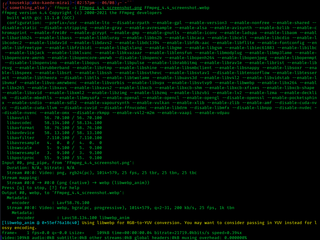
Fractal compression is a lossy compression method for digital images, based on fractals. The method is best suited for textures and natural images, relying on the fact that parts of an image often resemble other parts of the same image. Fractal algorithms convert these parts into mathematical data called "fractal codes" which are used to recreate the encoded image.

FFmpeg is a free and open-source software project consisting of a suite of libraries and programs for handling video, audio, and other multimedia files and streams. At its core is the command-line ffmpeg tool itself, designed for processing of video and audio files. It is widely used for format transcoding, basic editing, video scaling, video post-production effects and standards compliance.
Matroska is a project to create a container format that can hold an unlimited number of video, audio, picture, or subtitle tracks in one file. The Matroska Multimedia Container is similar in concept to other containers like AVI, MP4, or Advanced Systems Format (ASF), but is an open standard.

xine is a multimedia playback engine for Unix-like operating systems released under the GNU General Public License. xine is built around a shared library (xine-lib) that supports different frontend player applications. xine uses libraries from other projects such as liba52, libmpeg2, FFmpeg, libmad, FAAD2, and Ogle. xine can also use binary Windows codecs through a wrapper, bundled as the w32codecs, for playback of some media formats that are not handled natively.
RealVideo, or also spelled as Real Video, is a suite of proprietary video compression formats developed by RealNetworks — the specific format changes with the version. It was first released in 1997 and as of 2008 was at version 10. RealVideo is supported on many platforms, including Windows, Mac, Linux, Solaris, and several mobile phones.
On2 TrueMotion VP6 is a proprietary lossy video compression format and video codec. It is an incarnation of the TrueMotion video codec, a series of video codecs developed by On2 Technologies. This codec is commonly used by Adobe Flash, Flash Video, and JavaFX media files.
The following comparison of video players compares general and technical information for notable software media player programs.

Bink Video is a proprietary file format for video developed by Epic Games Tools, a part of Epic Games.
FAAC or Freeware Advanced Audio Coder is a software project which includes the AAC encoder FAAC and decoder FAAD2. It supports MPEG-2 AAC as well as MPEG-4 AAC. It supports several MPEG-4 Audio object types, file formats, multichannel and gapless encoding/decoding and MP4 metadata tags. The encoder and decoder is compatible with standard-compliant audio applications using one or more of these object types and facilities. It also supports Digital Radio Mondiale.

Indeo Video is a family of audio and video formats and codecs first released in 1992, and designed for real-time video playback on desktop CPUs. While its original version was related to Intel's DVI video stream format, a hardware-only codec for the compression of television-quality video onto compact discs, Indeo was distinguished by being one of the first codecs allowing full-speed video playback without using hardware acceleration. Also unlike Cinepak and TrueMotion S, the compression used the same Y'CbCr 4:2:0 colorspace as the ITU's H.261 and ISO's MPEG-1. Indeo use was free of charge to allow for broadest usage.
Avid DNxHD is a lossy high-definition video post-production codec developed by Avid for multi-generation compositing with reduced storage and bandwidth requirements. It is an implementation of SMPTE VC-3 standard.
libavcodec is a free and open-source library of codecs for encoding and decoding video and audio data.
The following tables compare general and technical information for a variety of audio coding formats.
FFV1 is a lossless intra-frame video coding format. It can use either variable-length coding or arithmetic coding for entropy coding. The encoder and decoder are part of the free, open-source library libavcodec in the project FFmpeg since June 2003. FFV1 is also included in ffdshow and LAV Filters, which makes the video codec available to Microsoft Windows applications that support system-wide codecs over Video for Windows (VfW) or DirectShow. FFV1 is particularly popular for its performance regarding speed and size, compared to other lossless preservation codecs, such as M-JPEG2000. The European Broadcasting Union (EBU) lists FFV1 under the codec-family index "31" in their combined list of video codec references.
CineForm Intermediate is an open source video codec developed for CineForm Inc by David Taylor, David Newman and Brian Schunck. On March 30, 2011, the company was acquired by GoPro which in particular wanted to use the 3D film capabilities of the CineForm 444 Codec for its 3D HERO System.

Libav is an abandoned free software project, forked from FFmpeg in 2011, that contains libraries and programs for handling multimedia data.
Sorenson Media was an American software company specializing in video encoding technology. Established in December 1995 as Sorenson Vision, the company developed technology which was licensed and ultimately acquired from Utah State University. The company first announced its codec at a developer’s preview at MacWorld Expo in January 1997.
Apple ProRes is a high quality, "visually lossless" lossy video compression format developed by Apple Inc. for use in post-production that supports video resolution up to 8K. It is the successor of the Apple Intermediate Codec and was introduced in 2007 with Final Cut Studio 2. Much like the H.26x and MPEG standards, the ProRes family of codecs use compression algorithms based on the discrete cosine transform (DCT). ProRes is widely used as a final format delivery method for HD broadcast files in commercials, features, Blu-ray and streaming.





